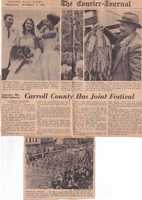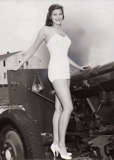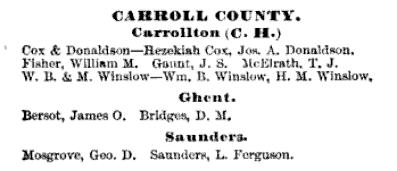
| Carroll County was the 87th county formed in Kentucky. The law enacting Carroll County was passed on February 9, 1838, and the county was formed on March 1, 1838 from parts of Gallatin, Henry and Trimble Counties. It was amended on February 16, 1838. Its boundaries are unchanged since February 5, 1872. It has an area of 130 square miles, making it the 118th largest of Kentucky's 120 counties. A thought about the formation of Carroll. |
The law that established Gallatin County in 1798, which at that time included what is now Carroll County, is here.
Discover the highest point in the county.
![]()
Chicago's Newberry Library has posted online a complete set of maps of American counties formations. They start with the date of county formation, and trace every little change to the boundaries after that. Carroll has had only 1 such changes, and you can see the Carroll maps here (pdf). To see the counties from which the county was formed, you'll have to download the entire Kentucky state pdf. There's also a feature that you can use to import all this data into Google maps. Good stuff! |
![]()
 |
 |
|
| Charles Carroll of Carrollton, Maryland, the man for whom Carrollton and Carroll County are named, and, the only Roman Catholic signer of the Declaration of Independence. You can read more about him at this site. |
Maryland Home of Charles Carroll Doughoregan |
|
![]()
| Here's a curious collection of documents from the 1860-1940's, from the post office, with town names, maps, and name changes. You really should start here, and they might make more sense to you. All are pdf's. | ||||
| Bramlette | Carrollton | Eagle Station | Easterday | English |
| Ghent | Jackson Springs | Locust | Prestonville | Sanders |
| Sandifers Store | Tandy | Worthville | ||
Can you name the nineteen town names in Carroll County that have had US post offices? That list is here.
Robert Rennick wrote this piece on Carroll Country post offices and the origins of their names fro the WPA.
![]()
This list of Carroll County deaths from WWII is from the National Archives. There's a key to
what the various abbreviations mean here, and the actual list is here.
The list from WWI is here.
![]()
From George W. Hawes’ Kentucky State Gazetteer and Business Directory,
for 1859 and 1860, comes
this listing (pdf) for Carrollton.
![]()
In 1876, the R. L. Polk Company published The Kentucky State Gazetteer and Business Directory, which listed information about virtually every town in Kentucky. The listings from Carroll County are these: |
||
| Bramlette | Carrollton | Eagle Station |
| Ghent | Locust | Prestonville |
| Sanders | Sandiferestore | Worthville |
![]()
Who's who in Carroll County in 1840, here.
![]()
“Mr. Lawrence. Now in Carrollton. Was in Bryant's Station (Wikipedia) when it was surrounded by Indians.”
Draper Papers, 15CC43
![]()
An earlier 1861 gazetteer has this listing for Carrollton.
![]()
| An updated Hawes gazetteer from 1883-84 lists these Carroll communities: | ||
| Carrollton | Eagle Station | English |
| Ghent | Liberty Station | Locust | Worthville |
![]()
| The 1878 Biographical Encyclopedia of Kentucky had these entries for folks with a Carroll County connection (all are pdf's) |
||
| Gen. Percival Butler | Gen. Wm. O. Butler | Richard Parker Butler |
| Thomas Langford Butler | Henry Giltner | L. W. Taylor |
| Lewis Sanders | Sam S. Scott | W. B. Winslow |
![]()
| An 1890 directory lists these Masonic Lodge members in Carroll County: | |
| Carrollton | Ghent |
| Membership lists of the Masonic Lodges in Carroll County, from 1911: (pdf's) | |||
| Worthville | Carrollton | English | Ghent |
For membership rolls of ALL Masonic Lodges in ALL cities in Kentucky,
from 1878 thru 1922, they're at the Hathi Trust Digital Library, by individual year.
![]()
| There are a total of thirteen Carroll Counties in the USA. Here's a list of the other 12. | ||
| Carroll County, Arkansas | Carroll County, Georgia | Carroll County, Illinois |
| Carroll County, Indiana | Carroll County, Iowa | Carroll County, Maryland |
| Carroll County, Mississippi | Carroll County, Missouri | Carroll County, New Hampshire |
| Carroll County, Ohio | Carroll County, Tennessee | Carroll County, Virginia |
![]()
| October, 1967, and I-71 is ready to open to Walton. (...and the Courier didn't know where English is) |

At one time, these high schools existed.
Consolidation and integration come to Carroll County Schools
| “Carrollton has 195 males and 173 females, total 368; Prestonville reports 40 males and 51 females; total 91. Ghent, 81 males and 103 females, total 194.” Courier-Journal, May 16, 1870 | “Destructive conflagrations have also occurred at . . . Carrollton, Ky., $100,000.” from a list of fires in the Los Angeles Star, August 24,1854 | |
| Items from Collins' History of Kentucky on Carroll County are here. Collins' History of Carroll County (pdf). | The African-American newspaper The Freeman offers these notes from 1911 Carrollton and these from 1893. | General Winfield Scott (Wikipedia), on a riverboat from Madison to Cincinnati gets fogged in at Carrollton in 1852. The story is at here, and a shorter version of his Carrollton speech is here. |
| A site dedicated to the bridges of Carroll County is here. | A letter in the Cincinnati Times in 1875 describes Carrollton, here. | An excerpt from Collins' History of Kentucky on prehistoric Carroll County formations is here. |
| “The Indiana Liquor Law has caused a brisk business to spring up at several points in Kentucky along the Ohio River. The owner of the ferry at Milton is reaping a fortune, and several citizens of Madison talk of erecting taverns in Milton. At Ghent, the jug business is carried on extensively; the horse ferry boat will soon give place to steam - as our Hoosier neighbors, to get steam will put on steam. At Carrollton, the jug traffic is improving, but after all, it may only prove to be an increased appetite for molasses.” - Carroll County Times, July 7, 1855 | ||
| A List of the first automobiles and their owners in Carroll County is here. | Timetable for the L&N, 1879, here, listing Liberty (Sanders), Eagle, Worthville & Carrollton. | The biggest crowd to ever assemble in Carrollton? Find out all about it here. |
It’s 1877, and the Carroll County Sheriff is on trial for murder. Stories here, and here and here. |
Owen County Sheriff in shootout in Carrollton, here. |
Then again, maybe this was the biggest crowd ever. |
Devastating tornadoes and heavy rains hit Carroll County on July 7, 1915. Read about them here and just across the river in Vevay, here. See the details of all the Northern Kentucky damage here. |
The Freeman, “An Illustrated Colored Newspaper,” was published in Indianapolis. Two items from it about Carrollton are here and here. | A Carroll County man that had four wives, 42 children, and a hat he's been wearing for 22 years. His story is here. |
| In 1906, the Courier-Journal published a list of out-of-state residents who would come home to Carroll County. | The Carroll County Chamber of Commerce published this history of the county.(pdf) | The latest news, 1859. |
| Mary Ann Gentry compiled some of the more interesting items (pdf) from the 1878 Carrollton Democrat. She's also written Old Port William (pdf). | The Carrollton Democrat was not a fan of the 15th Amendment (Wikipedia). | A History of Gallatin County, before Carroll County existed. |
| A visitor in 1880 describes Ghent and Carrollton. | A very early resident of Carroll County recalls early times. | A pair of voting precincts established in 1834, when Carroll was still part of Gallatin. One at Bethlehem Meeting House, and one at the Tavern House Ghent. |
| A report of progress on the Port William Methodist Episcopal circuit, 1834. | Details of a fox hunt, from Milton to Carrollton. | Indiana cyclists come thru Carroll County, in 1887 |
| In 1896, 13-year-old Sarah Eva Howe of Carrollton, Kentucky, imagined fanciful things and told captivating stories. She was a dreamer, a writer, a consummate story teller, and a keeper of family and community history. Sarah, and later her daughter Mary Alice Salyers Hays, bound the family’s memorabilia into 72 scrapbooks. There is a blog, 72 Scrapbooks - created in an attempt to preserve and share highlights from those treasured volumes. We found some of it boring, but some of it fascinating. Browse thru it - you'll find something you like. | ||
| One of Ghent's more famous citizens is James Tandy Ellis. Learn more about him at this site. | Lists of people in Carroll County Cemeteries are at this site, and this site. | The Carroll County Roots Web site is here. |
| The Cincinnati Commercial reported, on January 30, 1869, there were 8 doctors practicing in Carroll County. | ||
| In 1969, Edna Talbott Whitley compiled a list of Cabinetmakers in Kentucky. The Carroll County portion of that list is here. | You can get a glimpse of grass roots politics, in 1879 Carroll County, here. | In 1930, Kentucky Progress Magazine ran a feature letting each of Kentucky's counties list their accomplishments for 1929. What Carroll County came up with is here. (pdf) |
| The Steamer Redstone blows up between Carrollton and Ghent April 3, 1852. The story is here and here. This site has another five - ! - news article that covered the disaster. | Among those on the Redstone,(story at the left) was a bridal party which boarded at Madison. In the aftermath of the explosion, "the arm and hand of the young bride was all that was ever found of the body, and that was identified by the initials on the wedding ring that encircled her clammy fingers, and from which cruel death had failed to separate her." | |
| “’Who Was the First Man the ever settled in Carroll county?’ asked we, the other day, of Judge Cox, who knows as much of the county’s history s any other man. He replied: ‘There is a tradition in my family that a man named McCool, who settled at the mouth of McCool’s creek, was the first settler, and Green Owens says he received the same fact from his ancestors.’ This is no doubt true.” The Carrollton Democrat, April 5, 1884. | ||
| Larkin Sanders has legal issues in 1886, here. | You can read the proposal to build the Covington, Big Bone and Carrollton Railroad - going through Ghent - here. | In 1880, a visitor describes Ghent and Carrollton, here. (pdf) |
“The Carrollton Station Stage is doing a thriving business, so is the Worthville Stage, and they are well conducted. Travel from here to the cities is now almost entirely by the Short Line R. R. The river is so low that there is almost no telling at what time the Mail-boats will be along. For instance, the Ben Franklin left Cincinnati late Saturday evening and did not reach here until Monday morning.” from an unnamed newspaper, October, 1872 |
||
| Buried treasure found in 1869 in Carroll County, here | “Bond's dog, the champion fox hound of Carroll county, having won the champion silver collar, the whole state is challenged, through the Carrollton Times, to contest his right to wear it. The test to be on ground in Carroll county selected by a committee.” Daily Courier, March 8, 1868 | |
| Carroll County sites placed on the National Places of Historical Places are at this site. | ||
| A status report from the Superintendent of Schools in Carroll County from 1900 is here. The 1907 report is here. | “Arrangements are in progress and it is confidently expected that not exceeding five miles of the Ghent Turnpike in Carroll County, Kentucky, precisely opposite Vevay, Indiana, will be let on the same day, and under similar circumstances as the Vevay Turnpike. This road also is to be graded, bridged, and M’Adamized.” Indiana State Sentinel, Indianapolis, April 11, 1850 |
|
| The start of the Carrollton County Republican is documented here. | “In 1815 James McIntire laid out the town of Erin, opposite Carrollton, Ky., but was unsuccessful in his attempts to attract population at that point.“ from An Illustrated History of the state of Indiana,“ by DeWitt Goodrich, 1875. |
The story of the folks going to the penitentiary from Carroll County in 1896 is here. |
| The Kefauver Report (pdf), from the United States Senate Special Committee to Investigate Crime in Interstate Commerce had an appendix that listed gambling spots in found in Northern Kentucky. The Carroll County places listed are at the right. |  |
|
| In 1914, the Louisville Auto Club offered helpful routes to get to Cincinnati via Carrollton (and Indiana), and to Carrollton. | Carrollton Democrat says forget your politics, let's get some good roads. | Legislature permits a steam mill for Carrollton in 1818, when Carrollton was still a part of Gallatin County. |
| The Sharon Baptist Church was organized on March 19, 1825. We assume on Sharon Road. The first entry in their minute book, available in its entirety on microfilm at the library in Covington, Ky., is here (pdf). The second entry is the “Rules of Decorum” they established, here (pdf). | ||
| Environmental Report on the Ghent power plant, here. | Detailed Presidential voting statistics from Carroll County are here. | Buried Treasure upstream from Carrollton? Read more. A companion piece, here. |
 Indianapolis News, February 3, 1882 |
 Chicago Packer, March 10, 1917 |
 Chicago Packer, March 10, 1917 |
| C. 1928, the Kentucky Opportunities Department published a fact sheet about Carroll County for potential businesses that might be interested. You can read it here. (pdf) | The Interstate Commerce Commission moved part of Carroll County and Trimble County from the Central to the Eastern time zone at 2 a.m. on Sunday, July 23, 1961. | Warsaw's Dr. E. C. Threlkeld wrote a piece detailing Daniel Boone's travels through Gallatin County, from when Carroll was part of Gallatin. You can read it here. |
| The WPA compiled a list in 1942 of social organizations in Carroll. Their Guide to Civilian Organizations lists groups, and officers, but not members. It's 22 pages long, and the whole thing is online at UK. | ||
| Prominent Citizens of Carroll County, 1847, here. | Carrollton's treasurer's report, from 1890, is here. | A List of the Carroll County Historical Markers is at this site. |
| In 1835, Marie Barbe François Lakanal and her family settled in Carroll County (then Gallatin County). She notes her address as about three miles above Vevay, on the left. Anyway, she wrote a letter (pdf) back to her family in Europe, giving them detailed instructions on how to join her in America. | ||
![]()

Horticulturist and Journal of Rural Art and Rural Taste, September, 1874.

The 1961 Tobacco Festival
![]()
Anna V. Parker's A Short History of Carroll County (pdf).
from the Register of the the Kentucky Historical Society, January, 1959
![]()
| Myrtle Garvey wrote these several pieces of Carroll County History for the WPA in the late 1930's. They're all pdf's: | ||||
| County History | General Carroll Co. | Historical Sketch | Prestonville | |
| Early Settlement | Points of Interest | Rural Carroll | Worthville | |
![]()
 |
 |
| Kathryn Salyers From a Facebook post by Barbara Godman |
|
| Kathryn Salyers writes on the Early History of Port William (pdf). | |
| “In 1870, there were a total of 2,515 horses in Carroll County.” from the Carrollton News-Democrat, October 12, 1867 | In 1919, there was a farm census, counting livestock, crops and farms. Carroll County's is here. |
| “G. W. Anderson, of Carrollton, is shipping hickory nuts to Washington City, as if Congress have not already got enough tough nuts to crack.” Courier-Journal, December 11, 1876 | |
| “Carrollton is shipping pawpaws to the Cincinnati market.” Courier-Journal, September 12, 1876 | The Kentucky Department of Agriculture's assessment of agriculture in Carroll County, in 1898-1899 can be found here. (pdf) |
Carrollton's Ann Gillock, Miss Kentucky, 1955
![]()
Well, there was this Baptist preacher, George Bayard Waller, who got a girl pregnant, and fled to South Carolina.
A trial ensued, and a book was written:
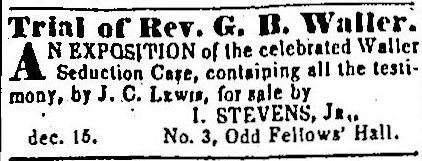
Alas, we've been unable to locate a copy of the book.
![]()
| Ancient Kentuckians dug up. |
The 1895 Carrollton Race Track, for foot races, bike races, and trotters, here. |
| In 1894, there were 32 one-room schools in Carroll County. The list is here. The 1897 list is here. | From 1885 is not only a list of all the one-room schools, but also a description of the boundaries of each district. Read it here. (pdf) |
| There are some early Acts of the Legislature in the Gallatin County section of these pages that pertain to Carroll County when it was still a part of Gallatin County. Read some of them here. | Carroll County's John Davis, of the 17th Indiana Mounted Cavalry, Company F, is a recipient of the US Medal of Honor in April of 1865 for his actions in in capturing the flag of the Worrill Grays (C.S.A.) in Culloden, Georgia. He died and is buried in what is now the ghost town of Cotopaxi, Colorado (Wikipedia). |
| In 1937 UK released surveys of known archaeological sites by county. Carroll County’s is here. (pdf) | An 1843 gazetteer describes Carrollton as having “a court house, jail, 3 churches - 1 Presbyterian, 1 Methodist, and 1 African - 7 stores, 1 steam saw mill, and about 850 inhabitants.” |
| William Peachy was the recipient of a large land grant which covered a very large portion of what is now the Carrollton area. 613 acres on the point were acquired from Peachy by Benjamin Craig and James Hawkins, and they subsequently sold smaller parcels of the land. The Butler Park land was also a part of Peachy's original grant. And the name Port William? It's named after William Peachy. | “A couple from the other side of the Ohio river applied at the County Clerk's office for a marriage license Wednesday. The clerk, however, refused to issue the license and they departed, vowing to go to Vevay, Madison, or somewhere else, as they were determined to marry. The man appeared to be considerably under the influence if liquor, which probably accounts for his desire to give up liberty and single blessedness.” Carrollton Democrat, September 10, 1870 |
The Carrollton Democrat of the 1870’s took great delight in sticking it to Gallatin County, and especially its newspaper, the Warsaw Record. An example: “The [Warsaw] Record still persists in being “as independent as an iceberg” and explains itself thus: “It simply means that no man or party can govern us no more than they can an iceberg.” By all means let the Record stick to its iceberg and - to its grammar.” From the Carrollton Democrat, January 25, 1873. |
|
| “An omnibus line is to commence its daily trips this morning from Carrollton to Worthville.” Courier-Journal, March 6, 1871 | “The stage from Carrollton to Worthville, in connection with the Short-line railroad, now runs only when there are passengers.” Courier-Journal, April 17, 1871 |
![]()
| The National Register of Historical Places lists these applications. Each is a pdf, and most contain, detailed descriptions maps, and pictures. | ||
| Carrollton Historic District | Ghent Historic District | Hunters Bottom Historic District |
![]()
| Two early “western” travelers visit Carrollton: | F. Cuming in 1807 | John Woods in 1820 |
![]()
 |
 |
| Larry Mahoney and the Carrollton Bus Crash, at this site. (Wikipedia) | |
![]()

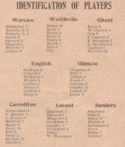
26th District Basketball Tournament Program, 1933
![]()
![]()
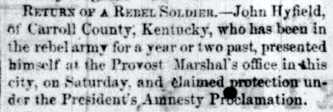
Cincinnati Daily Commercial, Februarhy 9, 1864
| Was there a woman spy in the Civil War from Carrollton? This says yes. | Citizens of Trimble County, Carroll County, and Madison, Indiana meet in April of 1861 to avoid Civil War Hostilities. Read the story here, and follow-up stories here. |
| “It is reported that a rebel force of from four to five hundred were in Carroll county last night, with the view of crossing to Vevay, Indiana.” Daily Alta California, July 29, 1864 | |
| Rebels occupy Carrollton, “a strong secession town,” in 1862. | Carroll passes the bounty fund. |
| “Colonel G. W. Berry, Provost Marshall of this district [for the Union], received information yesterday that one of the enrolling officers for Carroll County was unable to make further progress in the discharge of his duties on account of armed resistance of the citizens. A detachment of soldiers was sent to his aid at once. We also learn that there is some trouble in Trimble County, threats of personal violence having repeatedly been made against the enrolling officers. The Cincinnati Enquirer, June 25, 1863 | Being with the Provost Marshalls' was a dangerous job in the Civil War. Witness the item to the left, below, and this. |
| Union troops shut down a pro-Confederate newspapers in Carrollton in 1862, here. | Horrible atrocities by rebel guerrillas, here. |
| “At 2 places between Carrollton and Madison, the Confederate flag is displayed to every passing steamer, particularly those descending the Ohio loaded with troops. These rebel ensigns are unfurled and vaunted to the breeze by females who flatter themselves that their sex will protect them.” Cincinnati Daily Enquirer, February 23, 1862 | |
Carroll County's Lt. Col. Moses Tandy Pryor, C.S.A.
![]()
During the Civil War, in many parts of the country, the population was generally more afraid of the home guard than the opposing army. The “home guards” were usually gangs of men more interesting in theft than defense. One of the more notorious in the Carroll County area was Capt. George M Jessee, about whom you'll find a lot about on our Civil War page. |
![]()
| “Among Carrolltonians, It Is the Fad, the Fashion, the Rage - It's everywhere.” “It” was bicycles, in 1898. The story is here. | Ghent's H. M. Froman wrote this piece on Carroll County in 1907. |
| W. W. Masterson obituary. | An extraordinary storm hits Carrollton in 1860. |
| 1860 Tornado does serious damage in Carroll. More here. | Curious relic found in 1883, here. |
| Kentucky gubernatorial candidate William Goebels (Wikipedia) speaks to thousands in Carrollton. | |
| “The first marriage in Carroll county took place March 29, 1837. The parties were John Neley and Nancy Adams, daughter of John McWilliams. The ceremony was by Rev. George Kendall.” Carrollton Democrat, July 2, 1898 | A 1904 meeting of the Eagle Valley Medical Society is described here. |
| The WPA writers created a picture of Carroll County from c. 1937. You can read it here (pdf). | Port Williams' David Wilson, 1728-1830. But the first article leaves out some details. |
| A preacher on a temperance mission in 1833 passes from Boone County, through Gallatin and ends up in Ghent and Port William. He's generally appalled by the drunkenness he encounters. | “A debating society in Carroll county, Kentucky, is discussing the question, ‘Whether General [Andrew] Jackson was a greater man that Jesus Christ.’ Most people in Kentucky regard this question as already settled. You can never convince them that Jackson had any failings.” Daily Alta California, December 22, 1875 |
| The Geological Survey of Kentucky did a geological analysis of Carroll County in 1856. Read it here. (pdf) | A description of Port William from 1817 is here. He wasn't impressed. |
| “The Carrollton Courier is the name of a paper recently started in Carrollton, Ky., edited and published by T. D. Wright, Esq. The number before us looks well, and its editorials convince us the Editor is not a novice in the business.” from Vevay's Ohio Valley Gazette, September 11, 1851 | “The News, published at Ghent, Ky., is one of the few papers of the South which has a woman for an editor. Miss Angie Rice, a beautiful and accomplished girl, presides over the editorial columns of the News with much ability.” The Hartford (Ky.) Hartford Herald, January 11, 1905 |
| In 1890, the Carrollton Democrat reprinted its credentials from the very first issue of the paper, some “23 years ago.” Read it here. | My Grandfather told me that the road between Milton and Carrollton contained the longest stretch of continuously curved road in the state of Kentucky. That is, therefore, true. |
| Advocating for a telegraph in 1860, here. | Cholera (Wikipedia) hits Carroll County in 1873, here. |
| “Norwin Perry, hustling editor of the News-Democrat of Carrollton, Ky., spent a few minutes in Warsaw last Saturday with friends. After Norwin got through telling us of the good qualities of the citizens of Carrollton and Carroll county, he had us believing all the bad folks who had ever lived in that good county had died, moved away, were in jail, the penitentiary, or in the Kentucky Legislature. Now we, as a rule, have always believed everything Mr. Perry tells us, but Oscar Vest told us some time ago, that Perry Minor told him that Ed Seppenfield told him that George Lee said it was rumored by Emmett Orr that there was on some occasions, when Mr. Perry resided in Owen county, that his word for truth and veracity has been questioned.” Gallatin County News, April 7, 1934 | |
| “An organ grinder accompanied by a little girl was I town for a few days this
week. A beggar woman was also here.” |
”Carrollton, Ky., May 24. - Two and one-half inches of rain fell here Thursday night and it is still raining. Great damage has been done to the farms by washouts. One of the largest bridges between this city and Worthville has been washed entirely away. Travel is almost stopped. The Baptist church at Sanders, Ky., was struck by lightening and entirely destroyed. Loss, $1,500.” from the Hickman (Ky.) Courier, May 30, 1902 |
| “The G.M.C. Oil and Gas Company brought in their fourth gas well Saturday. 2,000 feet from their No.3 well at a depth of 800 feet. This well is located in Carroll County on the Aggie Owens farm and shows 1,500,000 cubic feet.” from the Maysville Daily Independent, July 6, 1931 | |
![]()
from Trow's Legal Directory of Lawyers in the United States, 1875
Lawyers of Carroll County, 1872, here.
![]()
Tollgate thought to have been somewhere in Carrol County.
From a Facebook post by Jamey Cobb
| “Carrollton, Ky., Dec. 19 - The Fiscal Court this evening bought the three remaining toll turnpikes in this county, a total of twenty-four miles at the price of $21,000. The gates will be thrown open tomorrow.” from the Earlington, Ky. Bee, December 22, 1898 |
| “Ghent, Ky., Feb. 13 - The first tollgate raid in the history of Carroll county occurred one-half mile above this place on the Ghent and Warsaw turnpike. All of the other pikes in this vicinity had been freed of tollgates. Many of the persons going through the gates refused to pay the toll. There is no clew [sic] to the identity of the persons who committed the act. The gatekeeper made no show of resistance and was not harmed.” from Maysville's Daily Public Ledger, February 13, 1899 |
![]()
“A story of a man that had a nose so large the he couldn't blow it without the use of gunpowder is said to be a hoax.“ Carrollton's Daily Democrat, October 11, 1870
|
|
 The Ohio Democrat, June 25, 1892 The Ohio Democrat, June 25, 1892
|
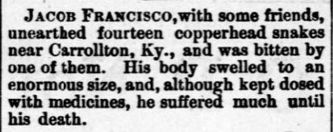 The Iola (KS), December 24, 1880 The Iola (KS), December 24, 1880 |
|
|
![]()
The Courier-Journal ran this feature on Carroll County.
A Bicentennial overview of Carroll County
Driving Tour of Carroll County
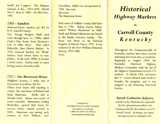 |
 |
Historical Markers of Carroll County
![]()
 |
 |
 |
| Louise Wilson Howe was a published poet from Carrollton. from the left, above, we have her picture and a bio, Christmas Greetings from Carrollton, and Autumn in Carrollton, Kentucky. | ||
![]()

